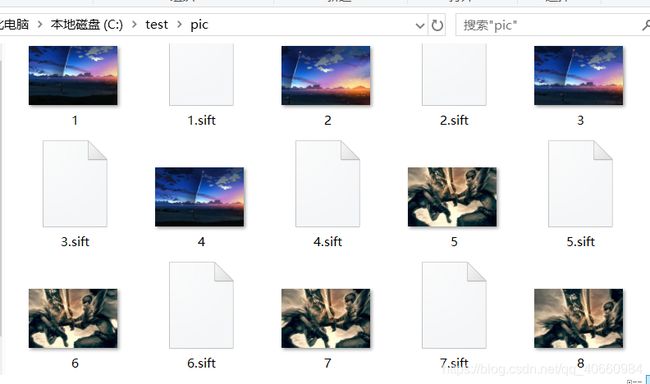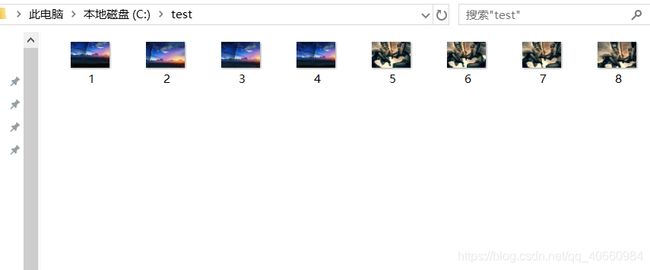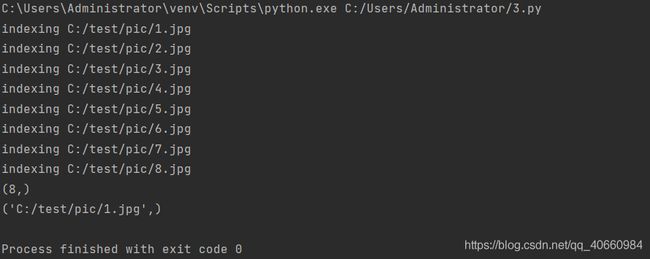python图像检索
关于图像检索
- 一、Bag of features算法
- 二、算法流程
- 三、实验过程
- 四、实验存在问题
一、Bag of features算法
此算法的思想是在我们先做一个数据集,然后找到图像中的关键词,这些关键词必须具备较高的区分度,最主要的操作就是提取sift特征,然后对这些特征点进行聚类算法,然后得到聚类中心,聚类中心就具有很高的代表性,这些聚类中心形成字典,然后自取一张图片,进行sift特征提取,就可以在字典里找到最相似的聚类中心,统计这些聚类中心出现的次数,然后就直方图表示出来,对于不同类别的图片,就可以训练处一些分类模型,然后就可以进行图片分类。
二、算法流程
1.收集数据集
2.提取sift特征
3.根据sift特征提取结果,进行聚类,得到一个字典
4.根据字典将图片表示成向量(直方图);
5.训练分类器或者用 KNN 进行检索
提取特征:
为了是图片具有较高的分辨度,使用sift特征提取,保证旋转不变性和尺度不变性,每个特征点都是128维的向量,将会提取很多的特征点
得到字典:
再次之前提取了很多的特征向量,然后就对这些特征向量进行k-means聚类,k值根据实际情况而定。聚类完成后,就得到了这 k 个向量组成的字典,这 k 个向量有一个通用的表达,叫 visual word。
三、实验过程
二、基于Bag of features算法的图像检索
2.1
读取图片,提取特征
代码
import pickle
from PCV.imagesearch import vocabulary
from PCV.tools.imtools import get_imlist
from PCV.localdescriptors import sift
from PCV.imagesearch import imagesearch
from PCV.geometry import homography
from sqlite3 import dbapi2 as sqlite
#获取图像列表
imlist = get_imlist('C:/test/pic/')
nbr_images = len(imlist)
#获取特征列表
featlist = [imlist[i][:-3]+'sift' for i in range(nbr_images)]
#提取文件夹下图像的sift特征
for i in range(nbr_images):
sift.process_image(imlist[i], featlist[i])
#生成词汇
voc = vocabulary.Vocabulary('ukbenchtest')
voc.train(featlist, 100, 10)
#保存词汇
# saving vocabulary
with open('C:/test/BOW/vocabulary.pkl', 'wb') as f:
pickle.dump(voc, f)
print ('vocabulary is:', voc.name, voc.nbr_words)
运行结果:

2.2
遍历图像,然后将向量特征投影到字典里并提交给数据库
代码
import pickle
from PCV.imagesearch import vocabulary
from PCV.tools.imtools import get_imlist
from PCV.localdescriptors import sift
from PCV.imagesearch import imagesearch
from PCV.geometry import homography
from sqlite3 import dbapi2 as sqlite
imlist = get_imlist('C:/test/pic/')
nbr_images = len(imlist)
#获取特征列表
featlist = [imlist[i][:-3]+'sift' for i in range(nbr_images)]
#载入词汇
with open('C:/test/BOW/vocabulary.pkl', 'rb') as f:
voc = pickle.load(f)
#创建索引
indx = imagesearch.Indexer('test1.db',voc)
indx.create_tables()
#遍历所有的图像,并将它们的特征投影到词汇上
for i in range(nbr_images)[:1000]:
locs,descr = sift.read_features_from_file(featlist[i])
indx.add_to_index(imlist[i],descr)
#提交到数据库
indx.db_commit()
con = sqlite.connect('test1.db')
print(con.execute('select count (filename) from imlist').fetchone())
print(con.execute('select * from imlist').fetchone())
3.3
进行查询测试
代码
import pickle
from PCV.imagesearch import vocabulary
from PCV.tools.imtools import get_imlist
from PCV.localdescriptors import sift
from PCV.imagesearch import imagesearch
from PCV.geometry import homography
from sqlite3 import dbapi2 as sqlite
imlist = get_imlist('C:/test/pic/')
nbr_images = len(imlist)
#载入图像列表
imlist = get_imlist('C:/test/pic/')
nbr_images = len(imlist)
#载入特征列表
featlist = [imlist[i][:-3]+'sift' for i in range(nbr_images)]
#载入词汇
with open('C:/test/BOW/vocabulary.pkl', 'rb') as f:
voc = pickle.load(f)
src = imagesearch.Searcher('test1.db',voc)
# index of query image and number of results to return
#查询图像索引和查询返回的图像数
q_ind = 7
nbr_results = 2
# regular query
# 常规查询(按欧式距离对结果排序)
res_reg = [w[1] for w in src.query(imlist[q_ind])[:nbr_results]]
print ('top matches (regular):', res_reg)
# load image features for query image
#载入查询图像特征
q_locs,q_descr = sift.read_features_from_file(featlist[q_ind])
fp = homography.make_homog(q_locs[:,:2].T)
# RANSAC model for homography fitting
#用单应性进行拟合建立RANSAC模型
model = homography.RansacModel()
rank = {}
# load image features for result
#载入候选图像的特征
for ndx in res_reg[1:]:
locs,descr = sift.read_features_from_file(featlist[ndx]) # because 'ndx' is a rowid of the DB that starts at 1
# get matches
matches = sift.match(q_descr,descr)
ind = matches.nonzero()[0]
ind2 = matches[ind]
tp = homography.make_homog(locs[:,:2].T)
# compute homography, count inliers. if not enough matches return empty list
try:
H,inliers = homography.H_from_ransac(fp[:,ind],tp[:,ind2],model,match_theshold=4)
except:
inliers = []
# store inlier count
rank[ndx] = len(inliers)
# sort dictionary to get the most inliers first
sorted_rank = sorted(rank.items(), key=lambda t: t[1], reverse=True)
res_geom = [res_reg[0]]+[s[0] for s in sorted_rank]
print ('top matches (homography):', res_geom)
# 显示查询结果
imagesearch.plot_results(src,res_reg[:5]) #常规查询
imagesearch.plot_results(src,res_geom[:5]) #重排后的结果
四、实验存在问题
一开始无法创建图像的特征点,python报错:sift not found
原因:

这三个文件不在自己的项目文件夹下
解决办法:
将这三个文件夹已到自己的项目文件夹下并找到sift.py文件用记事本打开,crtL+f找到cmmd一行

将里面的路径改为自己的sift.exe存在的路径
运行成功。





